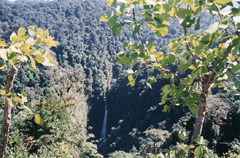
Dominican Republic: Background
 The Dominical Republic is a tropical island with mountains and fertile valleys. (Photo by Paula Freedman) |
|
The Dominican Republic is a beautiful Caribbean country. It stretches over two-thirds of the island of Hispaniola, which it shares with Haiti. It is a country of sandy beaches with blue waters and coral reefs, rich natural resources, green mountains, and vibrant towns and cities. On the north it is bounded by the Atlantic Ocean and on the south by the Caribbean Sea.
European settlement of the Western Hemisphere started in the Dominican Republic, with the arrival of Christopher Columbus in 1492. Yet for centuries before, Indians inhabited the island, which they originally called Quisqueya. They had their own way of life, consisting mainly of farming, fishing, and hunting. When the Spanish arrived, they brought great changes to the island's original peoples. The Indians there vanished within a century, due to disease and mistreatment by the Europeans. Some Europeans, like the Spanish priest Bartolomé de las Casas, campaigned to protect the native populations throughout the New World after he had first witnessed their ill treatment on the island of Hispaniola.
For nearly four centuries after the Europeans' arrival, countries such as Haiti and Spain sought to control the Dominicans, and the people suffered through revolts, invasions, and dictatorship even after becoming an independent nation. Now the Dominicans live in a republic where citizens vote for their leaders. Tourism, agriculture, sugar refining, and mining are important parts of the country's economy today. But even in this relatively small country, there are large contrasts, from rich and thriving city neighborhoods to poor ones, and from huge resorts to tiny villages.
The Dominican Republic possesses a lively Latin American culture, unlike the British, French, and Dutch influence on most other islands throughout the Caribbean Sea. The country is known for merengue, the rhythmic Latin music that is now popular throughout the Western Hemisphere, and for many colorful festivals and carnivals. The beauty of the country and the friendliness of its people draw many thousands of visitors each year to the Dominican Republic.
History Highlights
A.D. 450 (approximate): The first known settlers of the island
of Hispaniola, the Ciboneys, migrate from what is now the North American
continent.
A.D. 900: The Tainos, members of the Arawak tribal nation, come to the island and settle in villages.
1492: Christopher Columbus lands on the island on December 5. On Christmas Eve, his ship, the Santa Maria, is wrecked on the Atlantic shore. A settlement is established on the north coast.
1496: The city of Santo Domingo is founded on the south coast. The brother of Christopher Columbus, Bartolomeo, becomes the first governor of the colony.
1844: The Dominicans declare their independence from neighboring Haiti.
1916–1924: The United States sends in the Marine Corps to administer the country and establish order.
1960: Four women, the Mirabal sisters, are killed under a terrible government dictatorship because they are working for the rights of the people. Today, they are honored as heroines in the Dominican Republic.
1965: After unrest in the country, the United States again sends in the Marines to restore order.
1992: The country marks the 500th anniversary of Christopher Columbus's landing in the Western Hemisphere.
And Did You Know That...
- the Dominican Republic has more than 5,600 species of plants?
- many Major League baseball players come from the Dominican Republic? The city of San Pedro de Macoris touts its reputation as the birthplace of poets and writers — and many Major League Baseball players, such as Tony Fernandez, Jose Offerman, Mariano Duncan, Juan Samuel, Sammy Sosa, and Manny Alexander.
- a sugar production plant in La Romana, a city in the eastern part
of the country, produces 77 million pounds of sugar per year from sugar
cane? It is the largest sugar production facility in the world.
- carvings from the pre-Columbian era can be seen in the "Cueva
de las Maravillas" (Cave of the Wonders), located in the country's
southeast region?
Write about it: Learn more about Dominican
Republic in these selected Web sites: This page includes links
outside of Scholastic.com.
If the sugar production plant in La Romana, a city in the
eastern part of the country, produces 77 million pounds
of sugar per year from sugarcane. How many pounds does
it produce each day?
Every Web site we link to was visited by our team at one point in time
to make sure it's appropriate for children. But we do not monitor or control
these sites and these sites can change. In addition, many of these sites
may have links to other sites that we have not reviewed. Be sure to get
permission from your parents or teacher before leaving this site, and
remember to read the Privacy Policy and Terms of Use of any site you visit.
Bartolomeo de las Casas
http://www.hartford-hwp.com/archives/43/025.html
Spanish priest Bartolomé de Las Casas campaigned to protect the
native populations of the New World. Read the tale of Bartolome de las
Casas and see a timeline of his life.
Merengue
http://www.centralhome.com/ballroomcountry/merengue.htm
Read about merengue music and dance and learn about its origins.
The Taino Indians
http://www.indiana.edu/~speaweb/journal/jones/
Learn about the project to uncover the world of the Taino Indians.